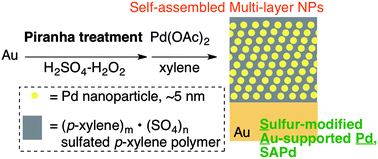The structure of a recently developed Pd catalyst, named sulfur-modified gold-supported palladium (SAPd), has been determined to be composed of multi-layered Pd nanoparticles. SAPd is easily prepared by self-assembly on a sulfur-modified gold surface, and near-edge X-ray absorption fine structure (NEXAFS) analysis at the Pd K-edge determined that the Pd in SAPd is zero-valence analogous to metallic Pd. However, transmission electron microscopy (TEM) analyses and extended X-ray absorption fine structure (EXAFS) analysis clarified that SAPd has approximately 10 layers and consists of nanoparticles with a diameter less than 5 nm. High-density Pd nanoparticles were embedded without condensation. NEXAFS analysis at the S and C K-edge revealed that the organic matter containing sulfate and xylene as a major ingredient is distributed between Pd nanoparticles, and it seems to prevent condensation. These findings suggest that a highly efficient cross-coupling reaction, which was reported in earlier works, has been achieved by the high-density Pd nanoparticles.

